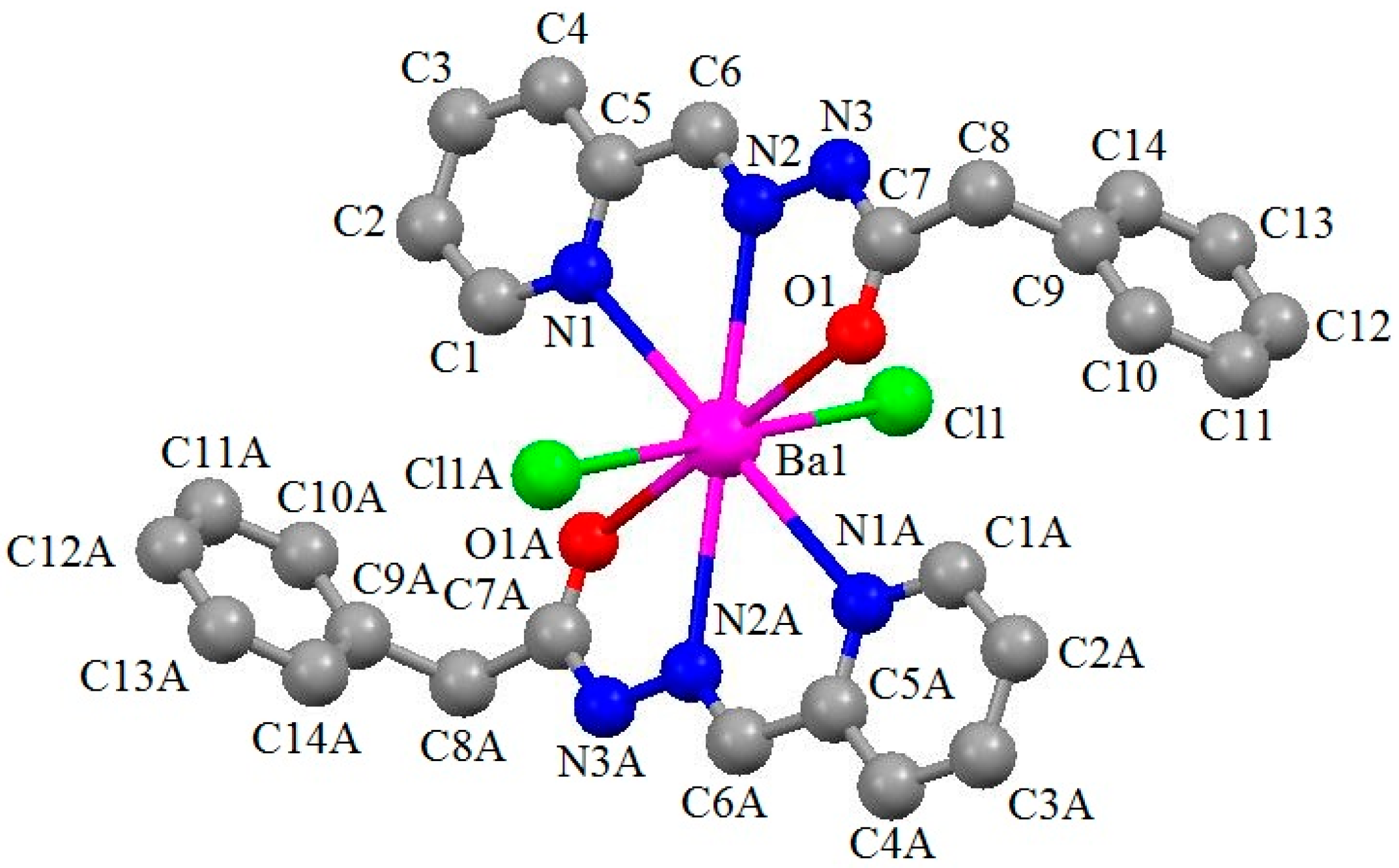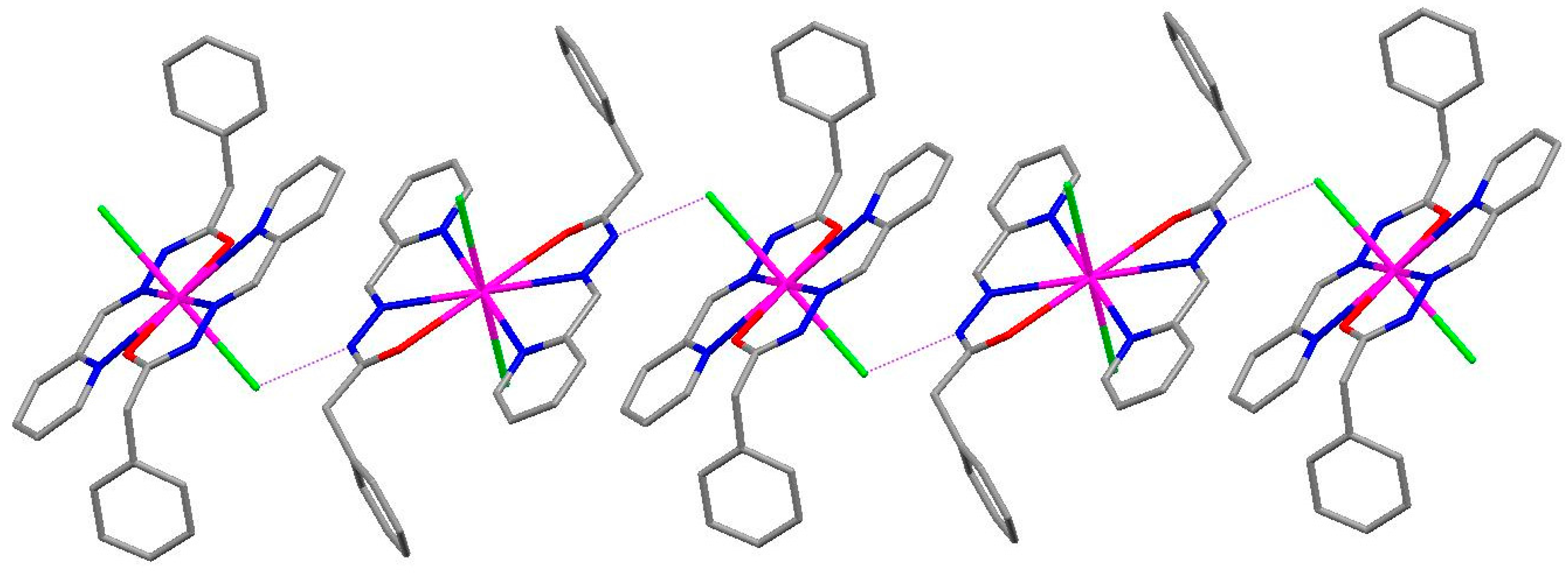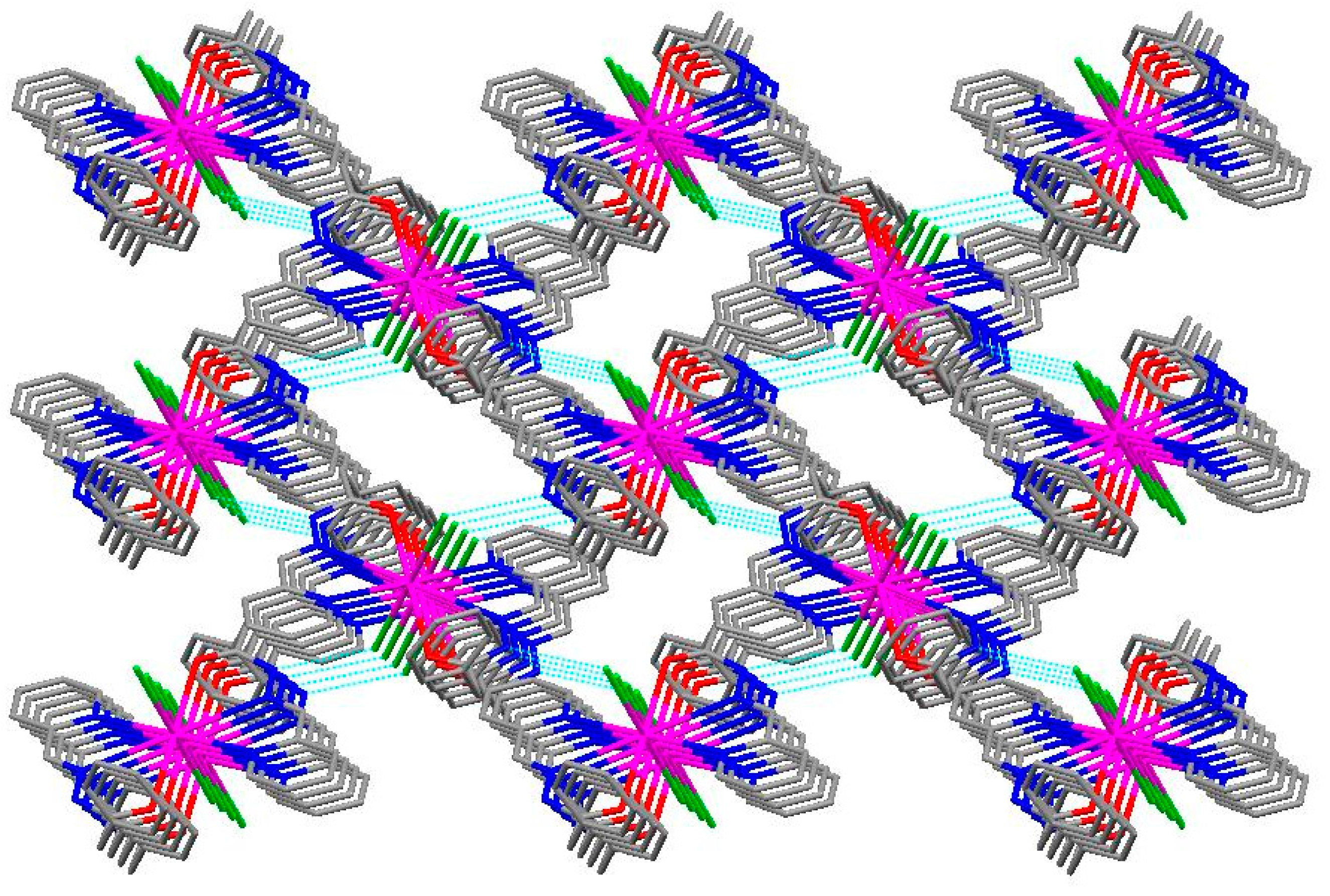Synthesis, Crystal Structure and Catalytic Activity of a Novel Ba(II) Complex with Pyridine-2-Carboxaldehyde-2-Phenylacetic Acid Hydrazone Ligand
Abstract
:1. Introduction
2. Results and Discussion
2.1. Structural Description of Ba(II) Complex
2.2. Catalytic Performance of Ba(II) Complex
3. Experimental Section
3.1. Materials and Instrumentation
3.2. Synthesis of Ba(II) Complex
3.3. Crystal Data Collection and Handling
3.4. Catalytic Test of Benzyl Alcohol Oxidation
4. Conclusions
Supplementary Materials
Acknowledgments
Author Contributions
Conflicts of Interest
References
- More, M.S.; Pawal, S.B.; Lolage, S.R.; Chavan, S.S. Syntheses, structural characterization, luminescence and optical strudies of Ni(II) and Zn(II) complexes containing salophen ligand. J. Mol. Struct. 2017, 1128, 419–427. [Google Scholar] [CrossRef]
- Hazari, D.; Jana, S.K.; Puschmann, H.; Zangrando, E.; Dalai, S. Three new Coordination polymers of zinc(II) and cadmium(II) with dicarboxylate and bipyridine ligands: Synthesis, structure and luminescence study. J. Inorg. Organomet. Polym. 2015, 25, 1151–1159. [Google Scholar] [CrossRef]
- Li, T.R.; Shao, Y.L.; Zhang, S.T.; Qin, J.C.; Fan, L.; Liu, L.; Wang, B.D.; Yang, Z.Y.; Wang, Y.H. Two dinuclear Zn(II) complexes for the fluorescent detection of 2,4,6-trinitrophenol. J. Lumin. 2017, 181, 345–351. [Google Scholar] [CrossRef]
- Wang, F.Y.; Xi, Q.Y.; Huang, K.B.; Tang, X.M.; Chen, Z.F.; Liu, Y.C.; Liang, H. Crystal structure, cytotoxicity and action mechanism of Zn(II)/Mn(II) complexes with isoquinoline ligands. J. Inorg. Biochem. 2017, 169, 23–31. [Google Scholar] [CrossRef] [PubMed]
- Nanjundan, N.; Narayanasamy, R.; Butcher, R.J.; Jasinski, J.P.; Velmurugan, K.; Nandhakumar, R.; Balakumaran, M.D.; Kalaichelvan, P.T.; Gnanasoundari, V.G. Synthesis, crystal structure, biomolecular interactions and anticancer properties of Ni(II), Cu(II) and Zn(II) complexes bearing S-allyldithiocarbazate. Inorg. Chim. Acta 2017, 455, 283–297. [Google Scholar] [CrossRef]
- Yang, Q.; Zhang, X.F.; Zhao, J.P.; Hu, B.W.; Bu, X.H. Cobalt(II)-azido coordination polymers with dicarboxylate and di(1H-imidazol-1-yl)methane ligands exhibiting ferromagnetic behaviors. Cryst. Growth Des. 2011, 11, 2839–2845. [Google Scholar] [CrossRef]
- Zeng, Y.F.; Zhao, J.P.; Hu, B.W.; Hu, X.; Liu, F.C.; Ribas, J.; Ribas-Arino, J.; Bu, X.H. Structures with tunable strong ferromagnetic coupling: From unordered (1D) to ordered (discrete). Chem. Eur. J. 2007, 13, 9924–9930. [Google Scholar] [CrossRef] [PubMed]
- Ferko, P.J.; Withers, J.R.; Nguyen, H.; Allison, C.; Ema, J.; Ema, T.; Rath, N.P.; Zhang, Y.Z.; Holmes, S.M. Synthesis and characterization of first row transition metal p-toluenesulfonate complexes and chains. Polyhedron 2017, 123, 344–352. [Google Scholar] [CrossRef]
- Tyagi, P.; Tyagi, M.; Agrawal, S.; Chandra, S.; Ojha, H.; Pathak, M. Synthesis, characterization of 1,2,4-triazole Schiff base derived 3d-metal complexes: Induces cytotoxicity in HepG2, MCF-7 cell line, BSA binding fluorescence and DFT study. Spectrochim. Acta A Mol. Biomol. Spectrosc. 2016, 171, 246–257. [Google Scholar] [CrossRef] [PubMed]
- Zhang, Y.C. Synthesis, crystal structure, and fluorescent property of a Zn(II) complex with N-nicotinoylglycine ligand. Crystals 2017, 7, 151. [Google Scholar] [CrossRef]
- Wang, X.L.; Sha, X.T.; Liu, G.C.; Tian, A.X.; Lin, H.Y. Structural influencing factors on ZnII/CdII coordination polymers based on a “V”-like bis-pyridyl-bis-amide derivative: Construction, fluorescent sensing and photocatalysis properties. Inorg. Chim. Acta 2016, 440, 94–101. [Google Scholar] [CrossRef]
- Tai, X.S.; Wang, X.; Li, P.F. Synthesis, crystal structure and luminescent property of a Cd(II) coordination polymer with a N-nicotinoylglycine ligand. Crystals 2017, 7, 33. [Google Scholar] [CrossRef]
- Luo, M.; Li, X.Y.; Chen, W.; Zhang, J.H. The catalytic activity of Zn(II) and Mn(II) organometallic complexes. Res. Chem. Intermed. 2013, 39, 2715–2721. [Google Scholar]
- Wang, X.L.; Wu, X.M.; Liu, G.C.; Li, Q.M.; Lin, H.Y.; Wang, X. Four thiophene-pyridyl-amide-based ZnII/CdII coordination polymers: Assembly, structures, photocatalytic properties and fluorescent recognition for Fe3+. J. Solid State Chem. 2017, 249, 51–57. [Google Scholar] [CrossRef]
- Selvamurugan, S.; Ramachandran, R.; Prakash, G.; Nirmala, M.; Viswanathamurthi, P.; Fujiwara, S.; Endo, A. Ruthenium(II) complexes encompassing 2-oxo-1,2-dihydroquinoline-3-carbaldehyde thiosemicarbazone hybrid ligand: A new versatile potential catalyst for dehydrogenative amide synthesis. Inorg. Chim. Acta 2017, 454, 46–53. [Google Scholar] [CrossRef]
- Sherif, Y.E.; Gouda, M.A.; El-Asmy, A.A. Synthesis, characterization, analgesic and anti-inflammation activity of new phthalazines and their Cu(II) and Zn(II) complexes. Med. Chem. Res. 2015, 24, 3853–3862. [Google Scholar] [CrossRef]
- Tai, X.S.; Wang, X.; You, H.Y. Synthesis, crystal structure and antitumor activity of a new Zn(II) complex based on N-acetyl-L-phenylalanine and 1,10-phenanthroline. Chin. J. Struct. Chem. 2016, 35, 586–590. [Google Scholar]
- Sayin, K.; Karakaş, D. Computational investigations of trans-platinum(II) oxime complexes used as anticancer drug. Spectrochim. Acta Part A 2018, 188, 537–546. [Google Scholar] [CrossRef] [PubMed]
- Tai, X.S.; Wang, G.L.; Liu, Y.Y. Synthesis and crystal structure of a Mg(II) complex with 2,6-pyridinecarboxylic acid. Sci. Study Res. Chem. Chem. Eng. Biotechnol. Food Ind. 2015, 16, 87–91. [Google Scholar]
- Tai, X.S.; Zhao, W.W. Synthesis, crystal structure and antitumor activity of Ca(II) coordination polymer based on 1,5-naphthalenedisulfonate. J. Inorg. Organomet. Polym. 2013, 23, 1354–1357. [Google Scholar] [CrossRef]
- Tai, X.S.; Zhao, W.W.; Li, F.H. Synthesis, crystal structure and antitumor activity of Ca(II) coordination polymer constructed by N-benzenesulphonyl-L-phenylalanine. Chin. J. Inorg. Chem. 2013, 29, 2200–2204. [Google Scholar]
- Tai, X.S.; Zhao, W.W.; Li, F.H. Synthesis, structural characterization and antitumor activity of a Ca(II)-schiff base complex. Chin. J. Inorg. Chem. 2013, 29, 1328–1332. [Google Scholar]
- Tai, X.S.; Zhao, W.W. Synthesis, spectral characterization, and luminescence properties of a cup-like ligand and its magnesium(II) complex. Res. Chem. Intermed. 2014, 40, 2075–2082. [Google Scholar] [CrossRef]
- Tai, X.S.; Yin, J. Synthesis, crystal structure and antibacterial activity of Mg(II) complex [Mg(H2O)6]·(4-amino-3-methylbenzenesulfonate)2. Crystals 2015, 5, 294–301. [Google Scholar] [CrossRef]
- Tai, X.S.; Wang, X. Synthesis and crystal structure of a 1D chained coordination polymer constructed from Ca2+ and 2-[(E)-(2-furoylhydrazono)methyl]benzenesulfonate. Crystals 2015, 5, 458–465. [Google Scholar] [CrossRef]
- Tai, X.S.; Zhao, W.W. Synthesis, structural characterization, and antitumor activity of a Ca(II) coordination polymer based on 1,6-naphthalenedisulfonate and 4,4′-bipyridyl. Materials 2013, 6, 3547–3555. [Google Scholar] [CrossRef] [PubMed]
- Tai, X.S.; Wang, X. Synthesis, structural characterization and antitumor activity of a Ca(II) coordination polymer based on 4-formyl-1,3-benzenedisulfonate-2-furoic acid hydrazide ligands. Crystallogr. Rep. 2017, 62, 242–245. [Google Scholar] [CrossRef]
- Sheldrick, G.M. SHELXT-Integrated space-group and crystal-structure determination. Acta Crystallogr. 2015, A71, 3–8. [Google Scholar] [CrossRef] [PubMed]
- Dolomanov, O.V.; Bourhis, L.J.; Gildea, R.J.; Howard, J.A.K.; Puschmann, H. OLEX2: A complete structure solution, refinement and analysis program. J. Appl. Crystallogr. 2009, 42, 339–341. [Google Scholar] [CrossRef]





| Bond | d | Bond | d |
|---|---|---|---|
| Ba1-Cl1 | 3.0214(11) | Ba1-O1 | 2.8330(19) |
| Ba1-N1 | 2.957(2) | Ba1-N2 | 2.8984(19) |
| C6-N2 | 1.268(3) | N3-C7 | 1.344(3) |
| C7-O1 | 1.221(3) | C1-N1 | 1.338(3) |
| C5-N1 | 1.343(3) | N2-N3 | 1.378(3) |
| Angle | ω | Angle | ω |
| O1-Ba1-Cl1 | 91.50(4) | O1-Ba1-Cl1A | 88.50(4) |
| Cl1A-Ba1-Cl1 | 180.0 | O1-Ba1-O1A | 180.0 |
| N1-Ba1-Cl1A | 91.59(4) | Cl1-Ba1-N1 | 88.41(4) |
| O1A-Ba1-N1 | 71.15(5) | O1-Ba1-N1 | 108.85(5) |
| N1-Ba1-N1A | 180.0 | N2-Ba1-Cl1A | 78.78(4) |
| N2-Ba1-Cl1 | 101.22(4) | N2-Ba1-O1 | 55.32(5) |
| N2-Ba1-O1A | 124.68(5) | N2-Ba1-N1 | 55.12(5) |
| N2-Ba1-N1A | 124.88(5) | N2-Ba1-N2A | 180.0 |
| Entry | Solvent | Temperature (°C) | Time (h) | Conversion (%) | Selectivity (%) |
|---|---|---|---|---|---|
| 1 | dimethylformamide | 130 | 6 | 9 | 28 |
| 2 | acetonitrile | 130 | 6 | 11 | 21 |
| 3 | 1,4-dioxane | 130 | 6 | 48 | 89 |
| 4 | 1,4-dioxane | 130 | 7 | 57 | 17 |
| 5 | tetrahydrofuran | 130 | 3 | 15 | 80 |
| 6 | tetrahydrofuran | 130 | 4 | 67 | 53 |
| 7 | tetrahydrofuran | 130 | 6 | 75 | 35 |
| Empirical Formula | C28H26N6O2Cl2Ba |
|---|---|
| Formula weight | 686.78 |
| Temperature/K | 293(2) |
| Crystal system | monoclinic |
| Space group | P21/c |
| a/Å | 12.464(3) |
| b/Å | 13.531(3) |
| c/Å | 8.8035(18) |
| β/° | 95.06(3) |
| Volume/Å3 | 1478.9(6) |
| Z | 2 |
| ρcalcmg/mm3 | 1.542 |
| μ/mm−1 | 1.559 |
| S | 1.098 |
| F(000) | 684 |
| Index ranges | −16 ≤ h ≤ 15, −17 ≤ k ≤ 17, −11 ≤ l ≤ 11 |
| Reflections collected | 13738 |
| Independent reflections | 3353 [R(int) = 0.0755] |
| Data/restraints/parameters | 3353/0/178 |
| Goodness-of-fit on F2 | 1.098 |
| Final R indexes [I ≥ 2σ (I)] | R1 = 0.0455, wR2 = 0.1079 |
| Final R indexes [all data] | R1 = 0.0494, wR2 = 0.1109 |
© 2017 by the authors. Licensee MDPI, Basel, Switzerland. This article is an open access article distributed under the terms and conditions of the Creative Commons Attribution (CC BY) license (http://creativecommons.org/licenses/by/4.0/).
Share and Cite
Wang, L.-H.; Tai, X.-S.; Liu, L.-L.; Li, P.-F. Synthesis, Crystal Structure and Catalytic Activity of a Novel Ba(II) Complex with Pyridine-2-Carboxaldehyde-2-Phenylacetic Acid Hydrazone Ligand. Crystals 2017, 7, 305. https://doi.org/10.3390/cryst7100305
Wang L-H, Tai X-S, Liu L-L, Li P-F. Synthesis, Crystal Structure and Catalytic Activity of a Novel Ba(II) Complex with Pyridine-2-Carboxaldehyde-2-Phenylacetic Acid Hydrazone Ligand. Crystals. 2017; 7(10):305. https://doi.org/10.3390/cryst7100305
Chicago/Turabian StyleWang, Li-Hua, Xi-Shi Tai, Li-Li Liu, and Peng-Fei Li. 2017. "Synthesis, Crystal Structure and Catalytic Activity of a Novel Ba(II) Complex with Pyridine-2-Carboxaldehyde-2-Phenylacetic Acid Hydrazone Ligand" Crystals 7, no. 10: 305. https://doi.org/10.3390/cryst7100305






